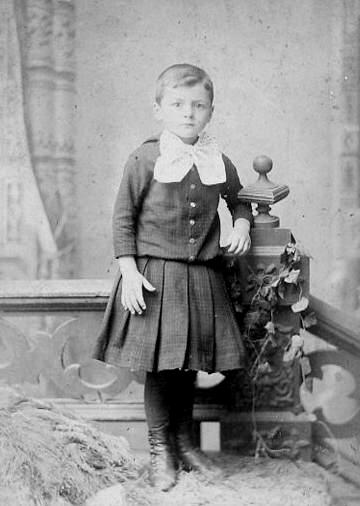
United States Boys' Clothes: Skirt Pleats--Definition

Figure 1.--This unidentified boy wears a skirt suit. He looks to be about 5, perhaps 6 years old. The blouse and skirt match forming what was probably called a kilt suit at the time. The skirt is pleated, but has no other kilt features. The skirt has box rather than knife pleats. The studio was Roshon in Lebanon, Peensylvania. The portrait is undated, but looks like the 1880s.
|
|
A pleat is essentially a fold formed by doubling the fabric back upon itself and then securing it in place. There are many different types of pleats. The most common pleat used in clothing is the knife pleat. It is the pleat used for the Highland kilt. Box pleats are a type of knife pleat, but dome back to back rather than as a series. The box pleats give the appearance of a wider pleat. The knife pleats are used for basic gathering and form a smooth line rather than springing out away from the seam they have been gathered to. The standard pleat is done in a 3:1 ratio–three, meaning that 3 inches of fabric will be needed to form 1 inch of finished pleat. Some motgers forned wider plears that did not require as much material. The practical purpose of pleating is basically to fit a garment so that it draws in close over smaller parts of the body (the waist) while becoming larger over wider parts of the body (the hips). In the case of kilts it becomes more a matter of style and fashion.
HBC

Navigate Related HBC pages
[Return to the Main American pleating page]
[Ringlet curls]
[Blouses]
[Ties]
[Skirts]
[Long stockings]
[Footwear]
Navigate the Boys' Historical Clothing Web Site:
[Return to the Main U.S. skirt page]
[Return to the Main U.S. kilt page]
[Return to the Main U.S. skirted garment page]
[Return to the Main U.S. country garment page]
[Introduction]
[Activities]
[Biographies]
[Chronology]
[Clothing styles]
[Countries]
[Bibliographies]
[Contributions]
[FAQs]
[Glossary]
[Images]
[Links]
[Registration]
[Tools]
[Boys' Clothing Home]
Created: 8:32 PM 10/14/2009
Last updated: 9:50 AM 9/1/2010



